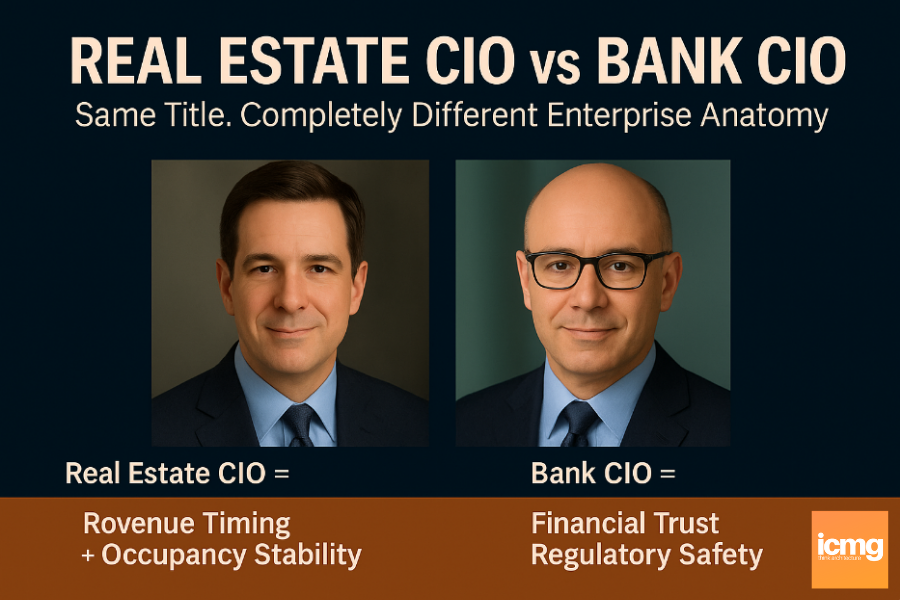Real Estate CIO vs Bank CIO : Same Title. Completely Different Enterprise Anatomy™.
- Sunil Dutt Jha

- 8 hours ago
- 3 min read

For years, the market has collapsed all CIO roles into a single stereotype — someone who keeps IT running, manages vendors, delivers dashboards, and upgrades systems.
But when you examine how different industries actually create value, serve customers, handle risk, generate revenue, and operate daily, you see something unmistakable:
A Real Estate CIO and a Bank CIO do not — and cannot — solve the same problems.
Because their enterprises are built on different anatomies.
Understanding those anatomical differences is the key to understanding modern CIO leadership.
Core Mission
Every CIO’s purpose begins with why the enterprise exists.
Real Estate CIO
Their mission revolves around turning land, development, leasing, and operations into predictable, monetizable assets.
They ensure the enterprise can move from concept → project → occupancy → recurring revenue without structural friction.
Bank CIO
Their mission is to protect and scale financial trust.They ensure deposits, lending, payments, risk, and liquidity work with absolute accuracy — because one misplaced logical rule can shake an entire economy.
Same title. Two completely different value-creation universes.
Daily Operational Focus
What consumes a CIO’s calendar tells you what the enterprise truly values.
Real Estate CIO
Coordinating design, construction, compliance & delivery
Ensuring leasing logic matches actual inventory
Managing tenant experience & asset value
Enabling revenue flows across properties and timelines
Their operational reality is physical, multi-party, geographically distributed, approval-heavy.
Bank CIO
Managing core banking stability and availability
Ensuring regulatory reporting integrity
Running fraud, AML/KYC, credit risk engines
Scaling digital channels across millions of users
Their world is digital, real-time, tightly regulated, zero-tolerance for error.
Architecture Pressure Points
Every industry has its repeating execution pain — this is where architecture gets revealed.
Real Estate
Project execution disconnected from portfolio economics
Leasing systems not aligned with construction readiness
Revenue recognition delayed due to scattered data models
Government approvals becoming architectural bottlenecks
Architecture collapses when physical progress and digital truth diverge.
Banking
Hundreds of IT projects layered without enterprise coherence
Core + cloud + digital + regulatory logic drifting apart
Data, risk, and product rules evolving at different speeds
Customer journeys broken across channels and systems
Architecture collapses when speed outruns anatomy.
What “Failure” Looks Like
Failure isn’t dramatic — it’s silent, slow, and structural.
Real Estate
Units handed over late without traceability
High vacancy despite strong demand
Revenue leakage due to poor contract logic
CFO unable to explain overruns
The business feels like it's moving — but value isn’t landing.
Banking
Regulatory findings and audit escalations
Customer complaints skyrocketing after outages
Fraud losses due to inconsistent rules
Technology spend rising without enterprise impact
The business feels modern — but anatomically vulnerable.
What “Success” Looks Like
Success is not an app, dashboard, cloud migration, or new system — it’s coherence.
Real Estate
One integrated view of project, lease, asset, and revenue
Predictable construction-to-cash cycles
Higher occupancy, better yield, faster turnaround
Data that matches physical reality
Execution becomes anatomically inevitable, not accidental.
Banking
One enterprise logic across risk, products, channels & data
Faster regulatory response with full traceability
Stable real-time operations with reduced complexity
Technology spend aligned with business outcomes
Execution becomes repeatable and anatomically defensible.
Why They Look Nothing Alike
Because the Enterprise Anatomy™ beneath them is different.
Perspective | Real Estate CIO | Bank CIO |
P1 – Strategy | Land, development, yield | Deposits, lending, liquidity |
P2 – Process | Project, procurement, leasing, FM | KYC, underwriting, payments |
P3 – Logic | Asset, pricing, approval rules | Risk, product, compliance logic |
P4 – Components | BIM, CRM, lease & asset systems | Core banking, LOS, fraud engines |
P5 – Tasks | Contractors, vendors, regulators | Auditors, regulators, fintech |
P6 – Operations | Properties, tenants, maintenance | Branch, call centers, digital ops |
Title similarity hides architectural reality.
Key Intelligence
CIOs aren’t interchangeable resources — they are enterprise-specific architects of value.
A Real Estate CIO succeeds because they understand land economics, leasing dynamics, construction rhythms, and asset monetization.
A Bank CIO succeeds because they understand transaction risk, regulatory pressure, financial products, and trust.
Expecting them to operate identically is not just unfair — it leads to bad hiring, poor strategy, and failed execution.
The CIO role must finally be understood through the lens of Enterprise Anatomy™ — not IT.




